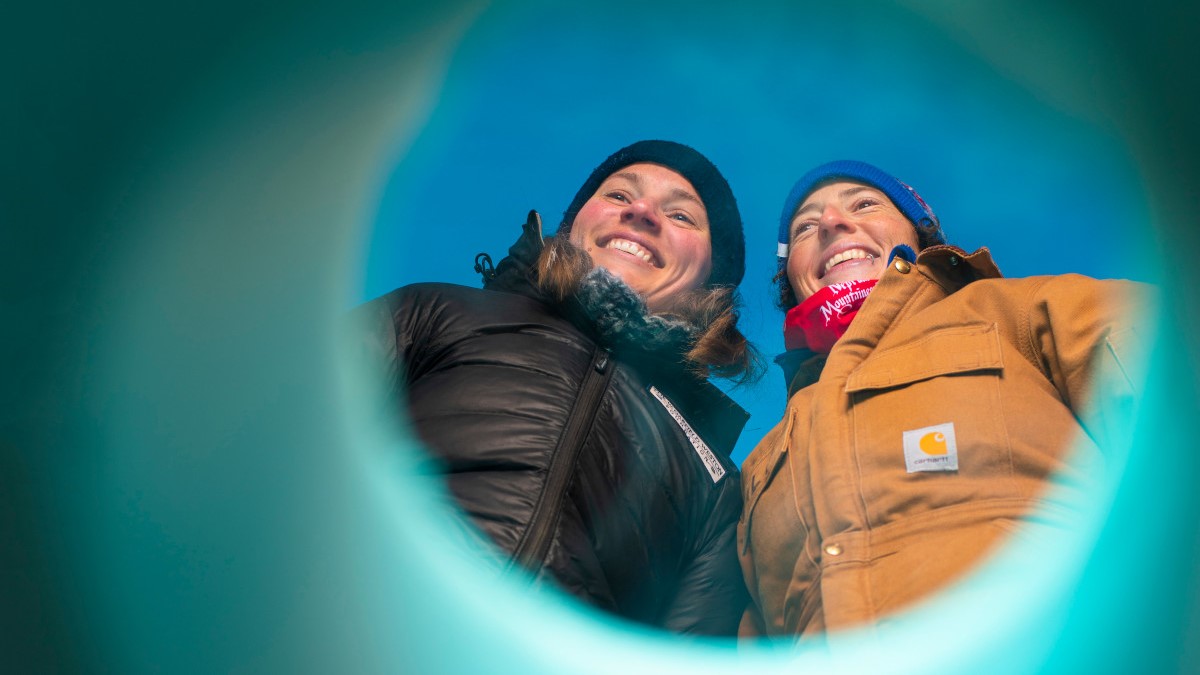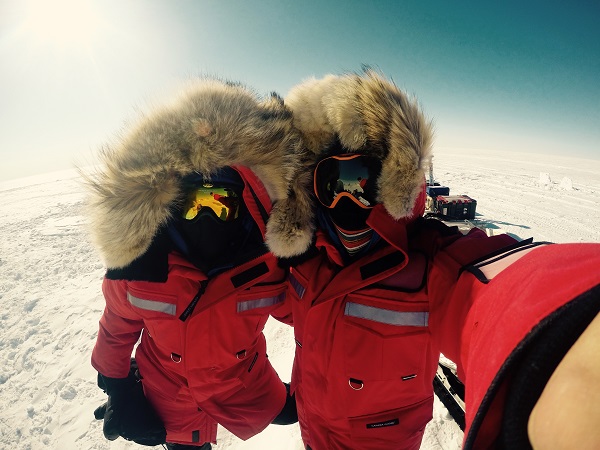
Ashley Dubnick (left) and Alison Criscitiello (right), along with Anja Rutishauser, are charting a new course for collaborations in Canadian Arctic science. Photo by John Ulan.
The Devon Ice Cap. Situated in one of the most extreme environments and remote locations on the planet, this cooler than cool environment is a literal hotbed of scientific discovery. Like all Canadian Arctic ice caps, Devon was assumed to be cold-based and frozen to the bed. Despite being well studied by scientists for decades, it took a Swiss PhD student studying in Canada to surprise everyone with a remarkable finding.
"At first, we thought this geophysical evidence for subglacial lakes beneath the cold-based interior of the Devon Ice Cap were impossible because the temperatures at the glacier bed are estimated below ~-10C," says Anja Rutishauser ('19 PhD). "Only after looking at the surrounding geology, we realized that the water is likely saline, so that it's freezing point is depressed, sourced from salty rocks that underlie parts of the ice cap. That's when we started to recognize that we discovered a worldwide unique subglacial water system."
This is not only the first subglacial lake discovered in the Canadian Arctic, it is also considered the first isolated hypersaline subglacial waterbody of its kind discovered on Earth.
This waterbody presents a unique scientific opportunity because it is an extreme potential microbial habitat, representing the combination of cold, salty, and dark conditions under pressure. These conditions make this subglacial waterbody one of Earth's most extreme environments and one of Earth's closest known analogues to extraterrestrial habitats hypothesized to exist on Mars, Jupiter's moon Europa, and Saturn's moon Enceladus.
That otherworldly component captured the attention of countless people around the world when the finding was first announced in the spring of 2018. And it's the opportunities presented by the project that are presenting potential to chart a new course for collaborations in Canadian science.
High risk, high reward
The heavily interdisciplinary (glaciology, biogeochemistry, geophysics, hydrology, microbiology, and fluid dynamics, to name a few) highly collaborative project has united scientists from seven universities so far, including the University of Alberta, McGill, Waterloo, Simon Fraser University, and the University of British Columbia, plus the University of Texas Institute for Geophysics (UTIG) and Montana State University. The project is spearheaded and led by Ashley Dubnick ('18 PhD), a postdoctoral fellow at the University of Alberta, Alison Criscitiello, Director of the Canadian Ice Core Lab housed at the University of Alberta, and Rutishauser, now completing a post-doctoral fellowship at UTIG. Not only is this one of the largest, most interdisciplinary projects to date led out of the Faculty of Science, it is also being led by three early career researchers who are all passionate about deepening our understanding of the Arctic.
"The Canadian Arctic is incredibly remote," says Dubnick, who in her graduate studies focused on the chemistry and microbiology of glacial ice and the meltwater that drains from ice sheets. "It's a huge landmass, 3.5 million square kilometres covered by a ton of coastline and 150,000 square kilometres of glaciers and ice caps. There's so much diversity in terms of the terrain.
"It's a harsh environment, but every nook and cranny is so unexplored and new, so the scientific opportunities are endless. It's an inspiring yet hugely understudied area, mostly because it's so remote and hard to access, and there's not a great funding structure within Canada to do research up there. We want to explore what adaptations have been created in this extreme environment to extend the definition of biodiversity on Earth," says Dubnick.
Big science, big support
How support came to be to move the project forward from Rutishauser's initial discovery is more poetry than science fiction.
Dubnick, a biogeochemist who completed her PhD studies with Professor Martin Sharp (earth and atmospheric sciences), was supported by The W. Garfield Weston Foundation during her graduate studies. Following her PhD, Dubnick completed a postdoctoral fellowship with Professor Emeritus John England (earth and atmospheric sciences), recently named Order of Canada and himself supported by the Foundation as the 2016 recipient of the Weston Family Prize for Lifetime Achievement in Northern Research.
The magnitude and potential impact of the Devon Ice Cap project and the mystery behind it motivated significant support from the Foundation, who have solely supported the first two years of exploration since.
"The discovery of these lakes is such big news, and it's so scientifically important, not to mention incredibly unique," says Criscitiello, a celebrated ice core researcher. "There was an energy around it, and we wanted to leverage the inertia of the discovery to turn this into something much bigger, cementing Canada's place in Arctic research.
"This project would not be happening without the philanthropic support of The W. Garfield Weston Foundation. There is no structure in Canada at the moment for funding huge science like this. It is high risk but high reward. Because it's such a massive investment, and it's coming from a foundation, it feels more personal."
Criscitiello details the uphill battle of getting beneath all that ice. Traveling to the Devon Ice Cap requires precision planning in logistics-a costly flight to Resolute, Nunavut followed by a bumpy flight on a small fixed-wing plane equipped with skis. The trip is further complicated by the need for optimal (yet uncontrollable) weather conditions that are typically sub -20C-some instrumentation doesn't work in extreme cold or cloud cover. And ultimately there is the question of the physical limitations of getting through 700 metres of ice to the water below. It means innovative approaches to drill through the ice, plus a new way of thinking about how to keep the water beneath pristine.
So why jump through all the hoops?
Redefining biodiversity
"This is a moment to change Canada's role in cryosphere research," says Criscitiello. "This salty, dark, cold, isolated environment means that there's a place on Earth that will allow us to ask questions about the extremes of life and biodiversity on our planet, and by extension, what may be possible on other planets where similar conditions are hypothesized to exist.
"Studying a hypersaline waterbody beneath 700m of ice requires state-of-the-art geophysical, drilling and sampling equipment that doesn't currently exist in Canada. This project aims to acquire that equipment and ultimately make it available to the Canadian scientific community. The equipment will allow scientists to make new observations with strong potential to revolutionize our understanding of polar science across disciplines, including glacier dynamics, glacier-ocean interactions and even the climate on Mars," continues Criscitiello.
"The equipment we hope to develop will be critical in allowing us to better understand ice dynamics and constrain sea level rise projections, which is particularly important to Canadians given the huge percentage of our landmass affected by sea level rise. Climate science affects everyone on the planet."
Despite the fact that we are a polar nation and that changes in the Arctic are widely accepted as a harbinger for changes we may one day experience on the rest of the planet, Canada has been historically behind other countries globally in terms of infrastructure and support for Northern research.
These scientists and their supporters are hoping this project serves as a critical tipping point to shift that, with huge spinoff impact on collaborations and opportunities for Canadian scientists and for science in general.
"The W. Garfield Weston Foundation believes that this type of ground-breaking research is the key to advancing a global understanding of unique northern ecosystems," says Geordie Dalglish, chair of the Northern Committee with The W. Garfield Weston Foundation. "We're thrilled to be supporting the project team's pioneering efforts to help unlock the mysteries of these subglacial lakes while advancing Canadian expertise on a global scale."
In terms of what comes next, the scientists remain not only optimistic but also curious.
"I am still extremely excited about this discovery, but even more determined to continue researching this unique subglacial environment through interdisciplinary and state-of-the-art investigations," concludes Rutishauser. "There are so many remaining questions about what lies beneath Devon Ice Cap."
